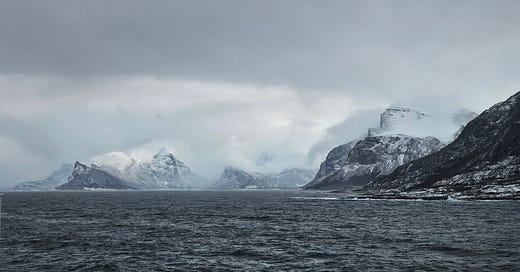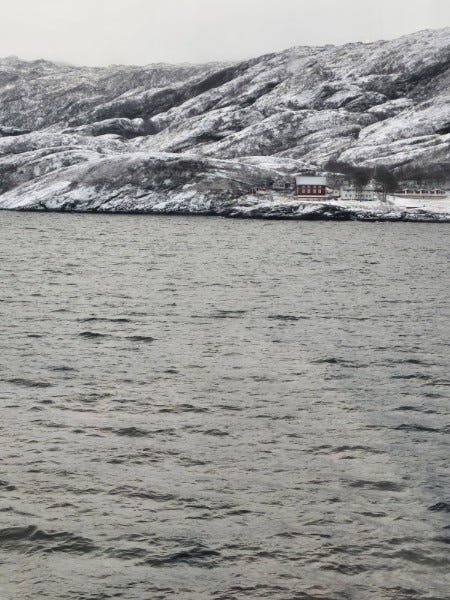Hurtigurten operates its ferries up and down the Norwegian coastline to small and middle-sized towns along the way. Once upon a time these vessels were critical lifelines; today, what they provide is convenience: delivering passengers, mail, palettes loaded with who-knows-what, cars needing transport from one inlet to another, and passengers like us, just along for the ride. We are on a working ship; we can be awakened in the middle of the night with the clunks of docking, the heavy metal creaks and bangs of loading and unloading, and the bright lights that keep workers and forklifts from falling into the drink.
Nasty weather has followed us from our departure from Bergen, providing a ready excuse to sit inside our glorified ferryboat and let the scenery slide by. Squalls come and go as we watch hills slowly form around us out of the rain and fog, the vessel bucking in the slate blue, white-capped ocean. The pilot threads the boat carefully through the shoals and skerries – tiny islets – that appear, then disappear, along our watery path. We seem to play chicken with dangerous rugged rocks jutting from the sea, only to suddenly veer left or right through a narrow gap known to the bridge but invisible to us landlubbers. We go from the relative safety of the rocky coastline to open ocean seas; we’ve learned to identify where we are from the way the vessel behaves, smooth and rough. Last night we hit a rough patch during dinner and watched as waiters carrying our plates lurched like drunkards toward us. Passengers with canes (there are many of them on board) received escorts to their tables, sometimes one on each arm. We heard the occasional clatter of dinnerware hitting the floor. I ate with one hand while holding our (glass) water carafe with the other. This morning we crossed the Arctic Circle. Snow has accumulated on the deck. OUr ship is dwarfed by the jutting mountains on either side. They seem ominous now, covered in white and disappearing into the low cloud cover. We slide into and out of fog banks that reduce visibility to zero. It’s easy to think of ourselves as polar explorers traveling farther north into the unknown.
Prior to the cruise we spent a lovely eight days in Bergen, Norway’s second city. You can fly there, but the train through the mountains from Oslo is considered one of the most beautiful rail routes in Europe. We had to agree, admiring both the marvelous scenery and the engineering required to build the tracks through jagged mountains and glacier-carved valleys. There are something like 100 tunnels along the 100 kilometer route, including one tunnel in which the train makes a 90-degree turn.
Our choice of eight days in Bergen was not owing to an excess of caution about making our ship boarding deadline. Reflecting on our time traveling over the last year we are reinforced in our conviction that we’re most happy exploring smaller cities and towns for a longer period of time. Not only do we get to know a place more thoroughly, really learning how people live, but we do it at a slower pace. Nothing takes the joy out of travel for us like the forced-march slog of seeing five museums in three days. Besides, we need our daily naps!
Bergen is in a fjord, which is a steep valley with a U-shaped floor, formed by glacial erosion. Norway has more fjords than anyplace on earth, and Bergen is a good place to check out the geography. Another characteristic of fjords is the collection of scree and debris at the mouth of the valley, pushed there by the glacier. The glacier that created Sojnefjord, the largest in Norway, scraped away 800 cubic miles of bedrock from the surrounding mountains, and deposited it deep on the seafloor at the mouth of its valley formed by successive glaciers sanding down the geography. The debris left at the mouth can inhibit the heavier salt water from entering under the lighter fresh water coming from the valley streams and waterfalls, making the water in the fjord much less salty at the surface and more salty below. This in turn affects the kind, quantity and quality of fish caught there.
The inlets created by glacial action are numerous and somewhat parallel to one another, like fingers, creating the characteristic Norwegian coastline of long peninsulas. Wherever you walk in Bergen you are walking along a peninsula with water on either side of you. What an irony that this busy seaport should also have a history of fire. For almost a millennium Bergen was visited by major fires that wiped out parts or most of the city about every hundred years. At the Museum of Bergen archaeologists date the artifacts they dig up from the striations of ash they find as they dig, physical evidence of the cycle of building, fire, and rebuilding since the Middle Ages. What did they find? Well, not much. Bergen was and is a working town devoid of royalty, castles or the trappings of wealth that characterize other major cities. We saw lots of clay pipes, old swords and broken pottery in the museum. The museum also had a temporary exhibit on the centralization of laws in Norway some thousand years ago, more interesting than you’d think. First, the new system reflected a more just and humane approach to punishment, replacing corporal punishment with fines and focusing on restitution by the perpetrator rather than by the perpetrator’s family. There were also large sections devoted to inheritance of property, which must have been a legal headache at the time. Still is, I suppose.
The Munch collection at the local art museum was impressive and reminded us that the painter benefitted from checking himself into a Copenhagen sanitarium, a place popular among the neurasthenic elite in the early twentieth century. There is a real demarcation between Munch’s dark paintings from before receiving treatment and after. His later palette is brighter, happier. The artist known for his desperate Scream stopped his dark brooding and painted really lovely landscapes and portraits, for the most part.
We are on our ship for twelve days in total, coming back to Bergen for a few days before we head out to Portugal and the warmer climes of the Iberian Peninsula.









Not sure that the Munch alteration of character is a good thing. Wish we could discuss over lamb shanks and wine.
Hurdy Gurdy :) Let's dance my friends! I miss jazzing around together.